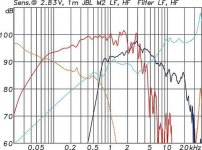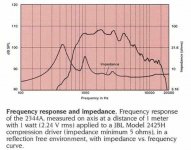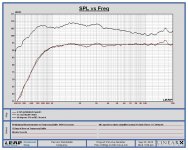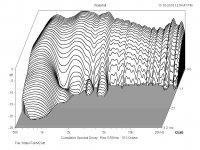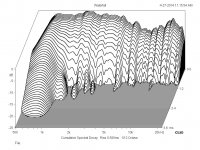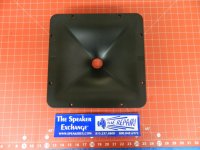Poor drivers and lack of EQ. But the first link looks like having incorrect measurements. I wouldn't trust those.I don't get the attraction to the 2344 and 2342 horns.
The peaks and dips probably caused by the slot have to be resonances that would show show up on a waterfall plot.
2342 response
JBL2342 Bi-Radial Horn @ AmpsLab
2344
2344
https://www.diyaudio.com/forums/multi-way/204222-jbl-2342-bi-radial-horn-revisited.html#post2858956
Take also note that the measurements posted of the 2344A horn uses much high resolution graphs compared to what's used today. You can get almost anything to look great with low resolution graphs.
Besides, a worse polar usually has much more influence on the sound compared to +/-2 dB abberation in the freq. response.
But either way, this isn't a problem with the combination of a modern driver and DSP.
Last edited:
...Chris, thanks for the recommendation on the adaptor, I wonder if it would adversely affect the response? I like your idea of a K-402 like waveguide mold.
It's the best adapter that I've seen for 1.5"-2", but of course the internal taper rate of whatever driver you choose to mate with it is a factor in its performance. Right now, there is no such thing as a K-402 1.5" throat horn, but as I stated, it would be very straightforward to produce one using a mold.
There was some effort in years past to improve upon this adapter to make it shorter. IIRC, no shorter developmental adapters had the polars vs. frequency and low HOM generation as the one supplied by TAD.
Note that I've been using those adapters on my TD-4002s for over a decade. I'm not going to give those up anytime soon.
Chris
I think avoiding reflections is more difficult in smaller rooms.use the system outdoors sometimes and in much larger than domestic spaces so controlled directivity as low as possible is desirable.
Here's an on-axis comparison between the M2 and 2344A horns without any EQ. A challenge of comparing is how the data are presented and I don't how how the M2 was measured. The M2 graph is with 21 db/decade. The 2344A graph is with 30 db/decade, which is more revealing. However, the 2344A response is shown with 12 dB oct. smoothing. The M2 graph may have no smoothing, but I'm not sure. The M2 measurements are from the german magazine Sound & Recording.
2017 M2 horn (blue curve):
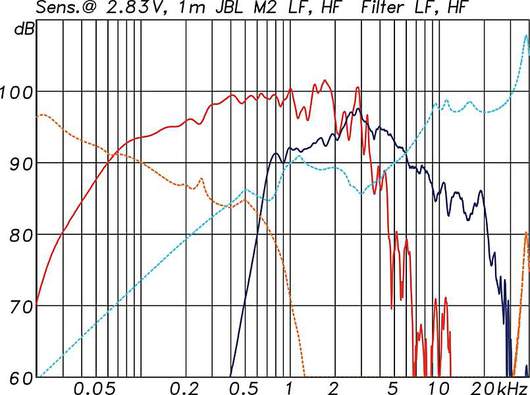
1981 2344A horn:

There really isn't much difference. Between 1KHz and 5KHz the M2 is somewhat flatter. Above 9KHz the 2344A bi-radial horn looks more even, but probably only because of a more smoothed graph. Obviously they use different drivers that may contribute.
2017 M2 horn (blue curve):
1981 2344A horn:
There really isn't much difference. Between 1KHz and 5KHz the M2 is somewhat flatter. Above 9KHz the 2344A bi-radial horn looks more even, but probably only because of a more smoothed graph. Obviously they use different drivers that may contribute.
Attachments
Thanks @Chris. I hope you make progress with the mold.
Omholt, thanks for the info. I have used several older JBL biradials over the years and I don't remember any of them sounding as good as the 2384 or some of these others from Brandon's driver vault measurements: Horns and Waveguides - drivervault
Especially the polars on the QSC QSC PL-000446-GP - drivervault Best waveguide I have heard to date, but it is a 1" and won't go low enough with a 15" in a two way...
Thanks for the link to Kenrick Sound - I could spend a week there listening! When I still was recording/mixing sound, one studio control room had the JBL 4425 with the baby butt cheeks. I really liked those and did look into the 4430/35's but could not find a pair anywhere near where I lived.
Omholt, thanks for the info. I have used several older JBL biradials over the years and I don't remember any of them sounding as good as the 2384 or some of these others from Brandon's driver vault measurements: Horns and Waveguides - drivervault
Especially the polars on the QSC QSC PL-000446-GP - drivervault Best waveguide I have heard to date, but it is a 1" and won't go low enough with a 15" in a two way...
Thanks for the link to Kenrick Sound - I could spend a week there listening! When I still was recording/mixing sound, one studio control room had the JBL 4425 with the baby butt cheeks. I really liked those and did look into the 4430/35's but could not find a pair anywhere near where I lived.
Wow, thank you, nice graphs.
Is that the newer pt h1010hf-1 ?
The 1 version is used in the am5212/00 and 7212/00.
Like the original without the bumps in the pth1010hf throat.
JBL 442730-001 PTH1010HF-1 Waveguide - Speaker Exchange
Is that the newer pt h1010hf-1 ?
The 1 version is used in the am5212/00 and 7212/00.
Like the original without the bumps in the pth1010hf throat.
JBL 442730-001 PTH1010HF-1 Waveguide - Speaker Exchange
Attachments
I don't get the attraction to the 2344 and 2342 horns.
The peaks and dips probably caused by the slot have to be resonances that would show show up on a waterfall plot.
2342 response
JBL2342 Bi-Radial Horn @ AmpsLab
2344
2344
Dispersion is important, i get it.
But not with a bunch of resonances.
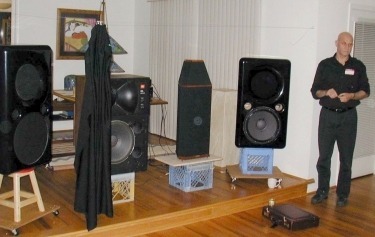
If I'm not mistaken, that was the speaker that Earl Geddes had before he built his own. Basically he designed his own speaker because the horn in the JBL 4425 was lacking. In the pic above, it's the speaker on the left.
Especially the polars on the QSC QSC PL-000446-GP - drivervault Best waveguide I have heard to date, but it is a 1" and won't go low enough with a 15" in a two way...
Thanks for the link to Kenrick Sound - I could spend a week there listening! When I still was recording/mixing sound, one studio control room had the JBL 4425 with the baby butt cheeks. I really liked those and did look into the 4430/35's but could not find a pair anywhere near where I lived.
I like the QSC a lot too.
An externally hosted image should be here but it was not working when we last tested it.
Right now I'm listening to these, and for the money, they are ridiculously good. I'll post some measurements this weekend. The thing that I like about these OS waveguides is that they basically sound like a nice dome tweeter, except they get way louder than a dome can.
I haven't torn the speaker apart completely, but it's basically a Celestion CDX1-1445 compression driver and what appears to be an Eminence Beta 12 (or a clone) in a nicely built cabinet for about $800 each. While it's true that someone could DIY this thing for about $100-$200 less, the fact that these are easily found on Craigslist is compelling. I paid $450 each for mine, and at that cost, I just can't do better even if I build it myself.
Another cool thing about the Yamaha DXR12 is that it uses FIR filters, so the phase and the polar response basically looks like the speaker is using a full-range, not a two way. The improvement is particularly noticeable on percussion.
Amazon.com: Yamaha DXR12 1100-Watt 1x12-Inch 2-Way Powered Loudspeaker: Musical Instruments
Can you call them OS when they are not round?
True story:
I flew to Denver to meet Earl Geddes at the RMAF, where he was demo-ing his speakers. I bought both of his books and stayed up late reading them.
I couldn't find the formula for the OS waveguide in his book, and it was totally bumming me out.
I asked him about it the next day. He wrote it down on a napkin, it's really simple. The OS curve is simply a spline that connects one angle to another angle. That's why it's critical to know the exit angle of the compression driver, and why you will ideally design an OS waveguide based on the compression driver that it's attached to. Also, I believe that's why Geddes has two or three patents on phase plugs.
Basically an oblate spheroidal curve is designed to create a smooth transition from the diaphragm of the radiator, all the way to the baffle of the loudspeaker. This is also why the Summas have a roundover on the baffle itself; you have to look at the entire thing as one continuous curve, from diaphragm all the way to the room.
The definition of the OS curve is two dimensional, so there's no reason that it can't be ellipitical, square, round, etc. Yes, this gets tricky at the throat because it's quite difficult to get the angles 100% correct at the throat if the waveguide isn't symmetrical. But there's a lot of good reasons to make a waveguide asymmetrical, so it kinda boils down to what your priorities are.
Personally, I think the biggest issue with diffraction these days is mostly manufacturing, if you look at a lot of waveguides they're not well-manufactured. Gaps in the throat are a huge problem.
...The definition of the OS curve is two dimensional...
This isn't actually true, Oblate Spheroidal is defined as a 3d co-ordinate system.
Obviously it's possible to use more or less similar curves to make ellipsoidal or other non round horns.
The optimum way to do this is still not obvious to me, despite a few decades that I have wondered about it.
Best wishes
David
I found these results for the HF200 driver:
https://community.klipsch.com/index...-faital-pro-hf200-driver-on-the-eliptrac400/&
It looks pretty great, managing down to 400 Hz with low distortion and the response at 30 degree off axis looks decent. No need for a crossover as well. 2" exit.
https://community.klipsch.com/index...-faital-pro-hf200-driver-on-the-eliptrac400/&
It looks pretty great, managing down to 400 Hz with low distortion and the response at 30 degree off axis looks decent. No need for a crossover as well. 2" exit.
- Home
- Loudspeakers
- Multi-Way
- 1.4" or 2" throat large constant directivity horns you can actually buy!
